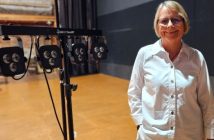For five decades, people from around the Waikato have been walking up a flight of stairs off Hamilton’s Ward Street to get their clothing altered. It is a remarkable run of continuity for the city business.
Early on Monday morning, May 9, 1971, Margaret Wallace walked up the stairs at 25 Ward Street in central Hamilton. She spent time making sure everything was in order, including her prized Bernina sewing machine, took a deep breath and at 8am, with a mixture of excitement and trepidation, opened the front door. Hamilton’s newest business, Margaret Wallace Clothing Alterations, was open for customers.
She had rent of $9 a month to pay for the first two months, $47 in the bank and no guarantee this would work out. But she was determined.
The Bernina had been bought the year before, from a Te Aroha dressmaker called Mrs Sleep, as Margaret had begun to think about starting her own business and getting ahead. “I was working for a tailor. And I thought, well, I can’t go on like this with a funny old car and renting a flat. I’ve got to do something about this.”
Aged 42, she was stepping into the unknown.
Fifty years later, she can still remember the first customer: “It was Mrs Ericsson, and her husband was the manager of the Waikato brewery.”
That first day she made $2, the clothing stores turned up in droves to give her business, and she was on her way.
The work poured in. They were long days, from 6am till 10pm, and seven-day weeks. That included working at home every evening and at weekends. There was no end of trousers to take up, suits and dresses to take in or let out, coats to alter, zips to replace. It was three years before she took her first holiday. “I worried myself sick the whole time I was gone.”
She also did curtains. “I used to get in the car at night and take the tracks and put them up at night time. I would work till 11 o’clock to fit the curtains. I had to do that to get where I wanted to be.”
Margaret was solo for the first 15 months before employing her first staff member. That followed advice from well-known Hamilton businessman Morty Foreman, who knew her from her previous job at Wilkinson’s.
“He came to see me and he said, ‘I’ll give you a few tips.’
“He said, ‘You’re working so hard, and you can’t do it with two hands. If you employ somebody, you’ll get more work. As you get more work that’ll make you more money. And don’t put your prices too high. Keep your turnover high by having your prices cheaper.’”
Margaret heeded his advice, and went on to employ eight staff as well as outworkers, as the business in the G E Clark building thrived. Customers came from across Waikato, and included the Masonic Lodge, the Police and the Fire Brigade.
Building owners G E Clark, who sold plants and grains among other products (“you name it, they sold it,” Margaret says), had an office upstairs as well as a shopfront downstairs. Her shop was off the landing to the right facing the street, and later shifted to the back of the building on the same floor.
“When I first went in, there was an old lady with a milk bar on the other side of the road, and there was the black and white coffee lounge. There was a barber shop, there was Pollock and Milne.”
Margaret also remembers a restaurant upstairs called La Gershinshaws, while she says Laurie Jenkins Menswear went in downstairs for a while before shifting across to the Government Life building which opened in 1980, followed by Centreplace in 1985.

From left: Susan Rowlands, Vicki, Margaret, Jackie Gough and Jacqui Brown with Helen Sisson, front, wearing Lions jerseys after they added numbers to them for the touring team.
And in the intervening years, Margaret got married (“the best thing I ever did”) and developed a loyal customer base. Now 92, her memories of the time are as sharp as ever.
One woman would come in to have her clothes let out. “I don’t know why I put this weight on,” she said to Margaret, “I hardly eat anything.” Soon after, Margaret popped across the road to the Diana Coffee Lounge to get a sandwich and noticed the woman sitting at a table, her plate loaded with pastries, from sponge cake to donuts.
Margaret can still recall the measurements for one particular lawyer. “Leg 28 and the bottom of his trousers, eight inches across. He just used to send them around with a girl and I knew what to do to them.”
Margaret also has a photo showing her and her staff wearing Lions’ jerseys made for much bigger frames. The back-up jerseys of the touring rugby team had been dropped off at short notice, for the numbers to be sewn on.
Then there was the time Margaret was phoned at 11pm because a netball team had realised they had left their uniforms behind and they were flying out at 7am the next morning. Margaret was in bed, but told the woman she was welcome to pop around, pick up the key, head into town for the uniforms and return the key once she was done.
And there was one man, a regular customer, who turned up at closing time on a Friday night to collect trousers that had been altered for him.
“He picked his trousers up and away he went, and I picked up my briefcase and away I went and locked the grille downstairs. I got a phone call about half an hour later, and they said there was a man on the premises climbing up on the inside of the grille. ‘You’d better come in because we can’t get him out.’”
It turned out the man had gone to the toilet on his way out, delaying him long enough that he was locked in, with no way of phoning anyone. In desperation he decided to scale the grille gate to try to get through a gap at the top, but got stuck while a crowd gathered outside.
To rub salt in the wound, he ripped his trousers. Margaret mended them at no charge, and he remained a very good customer.
“He took it in good part,” says Margaret of his ordeal. “He laughed.”

Margaret Wallace and Vicki Dromgool share memories of their
times with the business. The framed photo shows Margaret’s
sister wearing the wedding dress which Margaret made for her.
In 1994, Margaret sold up and was finally able to take longer holidays without constantly having the business on her mind. The name stayed, however, and on May 9 this year Margaret Wallace Clothing Alterations marks 50 years in the city, on the same floor of the same building it started in. It does so under the ownership of Vicki Dromgool, who was an employee of Margaret’s when she sold and continued under Correna Kirby’s tenure before buying the business herself in 1999.
The early ownership years were tough for Vicki, who inherited younger staff lacking experience, and she was busy. Things improved when she employed three “really good” staff members, Gail, Julie and Carol. Gail became Vicki’s mainstay, an “excellent seamstress”.
Times have changed, clothing has got cheaper after import licences were removed in 1992, and the standard of tailoring is not what it was. On a sunny afternoon at Margaret’s beautifully kept Hamilton home, the two women swap notes.
“Do you remember Thornton Hall?” Vicki asks. Margaret does indeed remember the New Zealand fashion label, which closed in 1997.
“They were the most beautifully tailored clothes,” Vicki says. “They were lovely to work on but they were intricate. Whereas now you don’t find stuff like that. We do quicker jobs now, because clothes are made so differently.
“You can sew down a side seam right through the hem now. That’s acceptable whereas you wouldn’t be able to in those days.”
“Oh no,” Margaret agrees. “To put a zip in a pair of jeans now you could just about go to the Warehouse and buy a new pair,” she says.
Vicki makes the point that at the other end of the scale a pair of jeans could cost $600. “Those are the things that I find that I’m doing, new zips in jeans that are expensive, new zips in suit trousers to keep them going.”
They also remember staff.
“The thing I realised is it’s not only me that put me where I am. It was having good staff and we all worked as a team together,” Margaret says.
Sadly, there have been bad experiences.
Both Margaret and Vicki have had staff steal from them. Margaret was also burgled five times, while Vicki remembers turning up at work one morning, when working for Correna, to discover the shop had been raided, with the burglars making their getaway by using cushion piping to lower themselves from the roof. The early Bernina is no longer in use, but other machines from Margaret’s time still are, including a blind hemmer, an overlocker and three plain sewers. However, they will soon be used elsewhere; on August 1, just over 50 years after opening for business, Margaret Wallace Clothing Alterations will end as Vicki follows Margaret’s footsteps and makes the most of her retirement.
She has spanned more than 30 years with the company, as employee and owner. And she has seen changes, not only to fashion but to the street.
“Ward Street has changed in that time. It used to be the busiest little hub in Hamilton,” she says.
Margaret, meanwhile, has outlived many of her former customers. One thing stays the same, however. “Even now, if I go to a funeral, I can pick a bad suit fitting,” she says.




